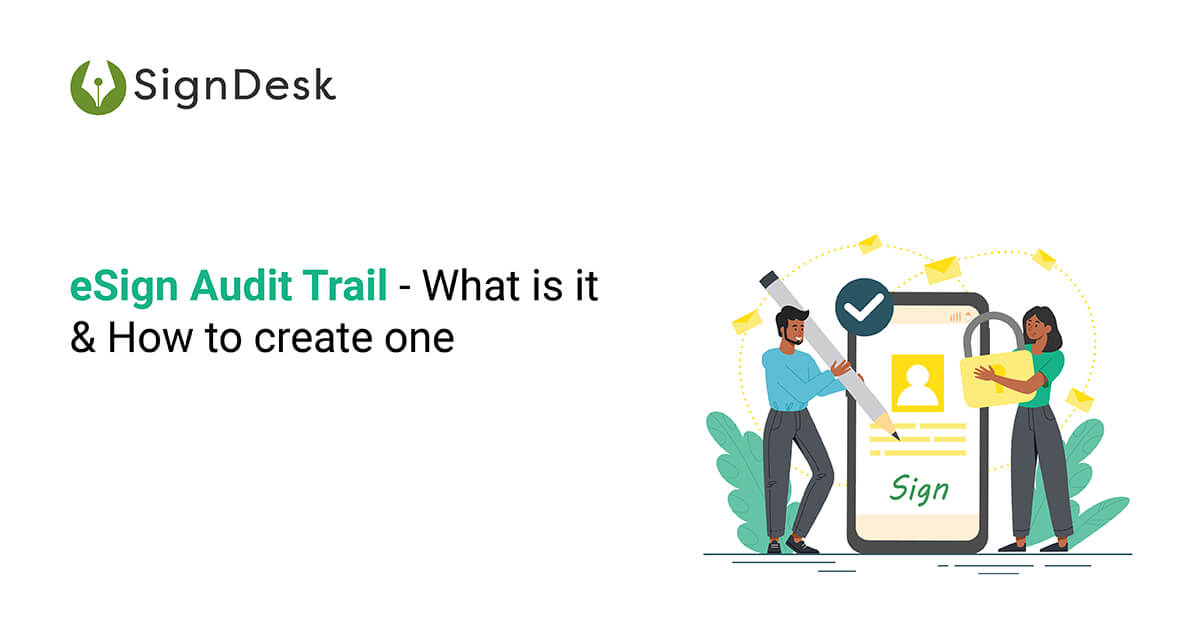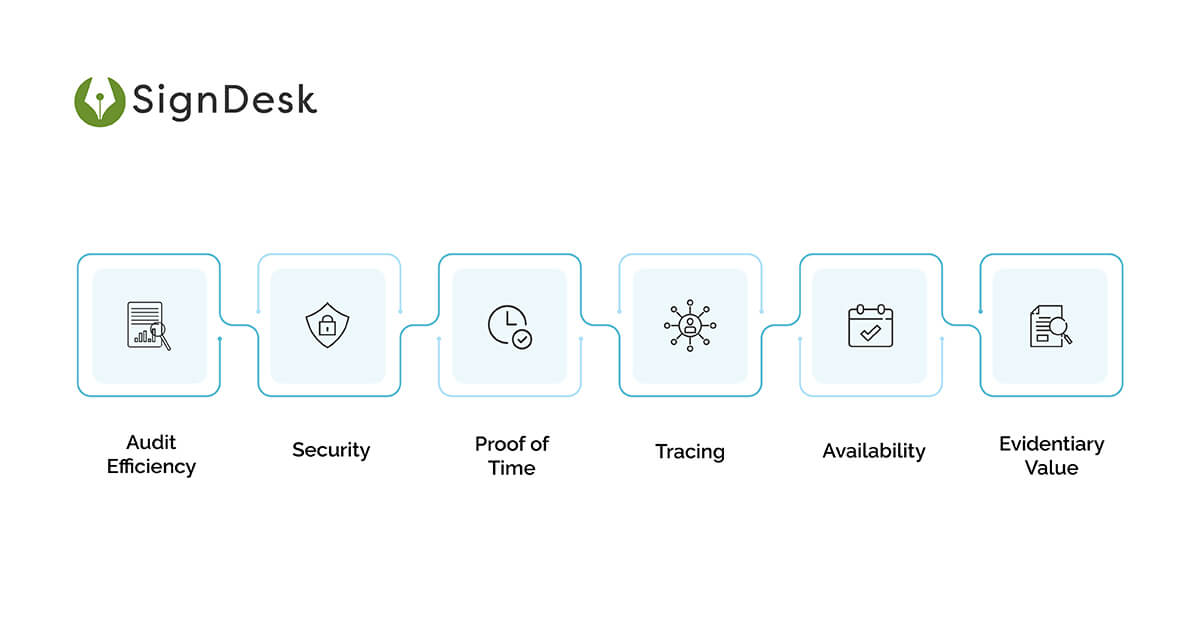How to Create a Virtual Audit Trail with eSignatures

What is an Audit Trail?
An audit trail is a detailed record that can be used to trace accounting, trade details, or other financial data back to its source. Numerous activities such as accounting, trading with brokerage firms, and business transactions, in general, are tracked and subsequently verified using audit trails whose electronic version is regarded as an esign audit trail.
Audit trails originate in the necessity for parties to an agreement to verify aspects pertaining to the obligations and execution of the agreement. For example – a fraudster could forge a written signature or spoof an identity to siphon money from accounts, and without a means to comprehensively verify the signature or identity, there would be no safeguard to various such instances of financial crime.
With the introduction of eSignatures, these difficulties were resolved. The electronic signature has proven to be a far safer option than a physical signature both as means to securely sign documents and verify the signature using digital signature certificates.
However, there have been some cases where a party claims to not have eSigned a contract at all and several instances in which cyber-criminals have gained access to digital signature keys or restricted roles in eSign software.
Since most business information is now secured using electronic signatures, the eSign audit trail has become a crucial & multi-purpose tool to verify the veracity of sensitive data, track suspicious financial activity, and audit businesses.
The electronic signature audit trail is, essentially, a digital record of when, where, and by whom a document was signed. This audit log or certificate of completion, allows businesses and auditors to validate each signature transaction and track it back to all the parties involved in the signature process.
In circumstances involving the legal review, the esign audit trail also provides detailed evidence.
What Does an eSign Audit Trail Contain?
The electronic signature audit trail must include precise information that allows any interested parties to verify the esignature’s legitimacy. The following details are needed:
- The signature’s date and time
- Verification of the individual signing the document (often by using an authenticated ID)
- Any changes made to the document during or after signing are documented.
- Every signer’s IP address
This information can be utilized to verify the signatures’ validity and authenticity. eSignatures are permitted to be used with legal documents precisely because of this authentication process.
Types of Audit Trails
For various sectors or objectives, there are three primary forms of audit trails:
- External Audit
CPA firms are often employed by businesses to do external audits in order to help them create a better and more trustworthy image of their finances. The final audit report contains the external auditor’s assessment of the company’s financial position.
- Internal Audit
Compliance, operational, financial, and information technology audits are all examples of internal audits. Employees from several departments can be cross-trained to objectively audit various departments to ensure that processes, protocols, and managerial tasks are executed correctly.
- Audits by the Internal Revenue Service (IRS)
An IRS audit is a popular sort of external audit (and one that you don’t want!). It’s usually done when there are indications that a person or company isn’t paying the right amount of taxes. In such cases, the IRS conducts audits to make sure a person or company’s financials match with their tax returns.
Features of an Audit Trail
An Audit Trail is a legal requirement that ensures the security of documents and data encrypted using an eSignature.The Audit Trail procedure includes the following features:

- Audit Efficiency
When there’s an audit trail for a transaction or agreement, all activities are automatically recorded for later verification and audits. When a document is modified, or parties are added or removed, eSign audit trails capture details including the time and the parties involved.
- Security
Audit Trails protect the authenticity of agreements by capturing all changes made to the agreement and recording key details pertaining to transactions.
- Proof of Time
Each Audit Trail contains a timestamp that is either local or centralized. If a local time is mentioned, the timezone is specified.
- Tracing
An audit trail must provide enough evidence to identify the person who edited or deleted the document, hence an audit is never without details. Updates are captured while safeguarding the prior version of the material.
- Availability
After receiving authorization, the archived data must be given for inspection.
- Evidentiary Value
An Audit Trail must be available for a period of seven years from the date of the eSignature, according to the IT Act of 2000. However, the electronic signature’s validity is guaranteed for the duration of the document, i.e until the eSigned document expires.
The Purpose of an Audit Trail
The objective of audit trails (or audit logs) is to eliminate fraud, material errors, and unauthorized use by acting as record-keepers that documentary proof of particular events, procedures, or operations.
Additionally, audit trails aid in the improvement of data security and internal controls.
The latter is defined under the Sarbanes-Oxley Act of 2002 (SOX) and the COSO Internal Control-Integrated Framework as financial controls, information security, data security, IT, computer system, software, cybersecurity, and business process controls.
Companies and people can use eSigning to finalize negotiations and contracts faster, gather crucial medical paperwork more securely and conveniently, and more.
Digital documents and electronic signatures are becoming more common in courts and the legal community, too. This is a significant achievement as the judicial system must adapt to the rising use of electronic formats by businesses and individuals. However, because of the nature of many electronically signed documents, it’s often questioned if they’re legal (and hence admissible in court).
How to Make Electronic Signature Audit Trails Acceptable in Court
While the IT Act (2000) and the Indian Contract Act ensure the legal validity of (certain types) of eSignatures in India, there are some best practices that can help ensure that electronic signatures are court-admissible and that their audit trails contain the necessary requirements to be used as evidence in legal proceedings. Since precision is vital when it comes to legal documents, the following features are vital in an eSign solution for legal purposes:
- Signers’ location, name, IP address, signing date and time, and both chronological and identifying information pertaining to document access and activities must be included in the audit trail
- The signer’s unambiguous desire and agreement to sign electronically must be made obtained and recorded
- The architecture must be a secure digital signature system, which includes a public key infrastructure (PKI) that creates public and private keys, and ensures that the document is encrypted, private, and secured from tampering
- A second identity verification step, such as two-factor authentication (2FA) is also recommended for added security
As per reports in just five years, the number of global eSignature transactions has risen from 89 million to 754 million. This increasing adoption of eSignatures is driving both adoption rates in the legal sector and security concerns.
Comprehensive and precise eSign audit trails are therefore quickly becoming a necessity for eSign platforms.
Additionally, with 41% of companies printing more than half of their paperwork and 48% of these companies making three or more copies of the same documents, improvements in business efficiency and document management are also among the long list of advantages afforded by eSign solutions.
SignDesk: Digitally Secure eSignatures
SignDesk’s eSign solution enables businesses to create, approve, and eSign documents online using legally valid eSignatures. With a secure and exact audit trail that captures all the details required to establish the veracity of eSignatures, Ink.it is an audit-ready solution for enterprises and legal firms.
Signers can use online eSign and document templates to sign documents instantly and remotely, with SignDesk’s smart management system to keep legal teams and executives on top of corporate documentation.
ink.it enables businesses to:
- Generate, eSign, and manage company documents in one place
- Streamline business documentation with eSign-enabled approval
- Generate documents online using configurable templates
- Sign documents electronically with Aadhaar or Digital Signatures, both legally binding electronic signatures
Once on SignDesk’s eSign platform, users can create eSignatures in the following ways:
- Workflow for eSign:
Individual documents can be signed by sending an OTP verification to the applicable party’s registered mobile number and email address. This OTP-based method is used in both Aadhaar and electronic signatures.
- Signatures based on USB Tokens:
In this hardware signature, a Digital Signature Certificate (DSC) is put in a USB Token. It uses the PKI (public key infrastructure) to establish signatures and can be accessed from a computer to sign documents in bulk online.
SignDesk streamlines the entire paperwork process for businesses of all sizes. SignDesk also offers legally valid templates for instant document preparation, eSign workflow for instant signatures, and digital stamping services for instant legalization which further bolsters the esign audit trail.